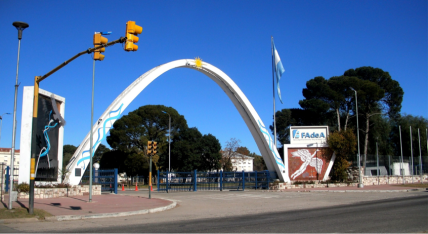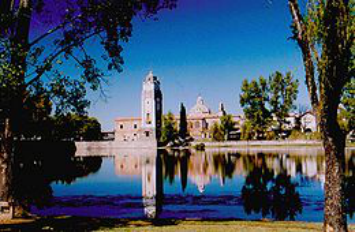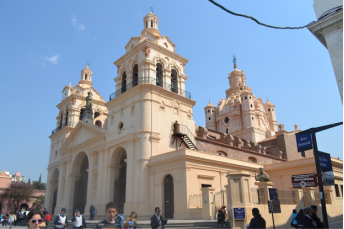Córdoba, Argentina 作者: 来源: 发布时间:2021-03-23
1. Population and Area
Córdoba is a city in central Argentina, in the foothills of the Sierras Chicas on the Suquía River, about 700 km (435 mi) northwest of the Buenos Aires.
Area:576 km2 (222 sq mi)
Population (2010 census):1,317,298

2.Geography
The climate of the city of Córdoba, and that of most of the province, is humid subtropical (Cwa, according to the Köppen climate classification), moderated by the Pampas winds, cold winds that blow from the South-western quadrant, which originate in Antarctica.
There are four marked seasons.The wealthier suburbs west of the city are located at slightly higher altitudes, which allows cool breezes to blow in the summer, bringing drier, comfortable nights during hotter periods, and more regular frost in the winter. Generally speaking, Córdoba's daytime temperatures are very slightly warmer than Buenos Aires' but nighttime lows are usually cooler, especially in the winter. This, combined to a lower humidity and the possibility of fleeing to higher altitudes minutes away from the city centre, makes the climate a bit more comfortable than in the capital.
The variations or thermal extents are greater than in Buenos Aires, and lower in annual rainfall: 750 mm (30 in) / year. The annual average temperature calculated during the 20th century was 18 °C. In January, the hottest month of the austral summer, the average maximum is 31 °C and the minimum 17 °C. In July, the coldest month of the year, the average temperatures are between 19 °C and 3 °C. In winter it is very frequent that temperatures rise above 30 °C, due to the influence of the wind Zonda.
Due to the extension of the metropolitan area, there exists a difference of 5 °C between the central area and the Greater Córdoba. The central district, a dense high-rise area is located in a depression, and it is the core of an important heat island. In addition the city presents a phenomenon of smog, but not so dense as to present health concerns.
Transportation:
The Córdoba public transport system includes trains, buses, trolleybuses and taxis. Long-distance buses reach most cities and towns throughout the country.
The city is served by the nation's third largest airport Ingeniero Ambrosio L.V. Taravella International Airport.
3. Economy
Since World War II, Córdoba has been developing a versatile industrial base. The biggest sectors is car and car parts manufacturing: Renault has a factory which produces a range of cars and Volkswagenhas a factory specialized in the production of gearboxes. The capital goods company CNH Industrialhas also a factory in the city. Many suppliers (both local and foreign) manufacture car parts for these operations. Additionally, starting in 2017–2018, Nissan and Mercedes-Benz will begin the production of their new pickup truck at the Renault factory. Railway construction (Materfer) and aircraft construction (Fábrica Militar de Aviones) were once significant employers, but their activities have greatly diminished. Furthermore, there are some textile, heavy and chemical industries (e.g. Porta for alcohol).
Areas around Córdoba produce vast amounts of agricultural products, and some of these are processed around the city. Additionally, the province is one of the main producers of agricultural machinery in the country, although most of these operations are not in the city itself. Candy company Arcor is headquartered in the city.
Córdoba has been considered the technological centre of Argentina. The Argentine spaceport (Centro Espacial Teófilo Tabanera), where satellites are being developed and operated for CONAE, is located in the suburb of Falda del Carmen. The software and electronic industries are advancing and becoming significant exporters; among the leading local employers in the sector are Motorola, Vates, Intel, Electronic Data Systems, and Santex América.
The city also has a service-based economy focused on retail, professional services (with companies like Deloitte) and financial services, where the main local player is credit card provider Tarjeta Naranja. It has recently emerged as a start-up hub with a growing number of angel investors, in part due to the availability of people with technology-oriented skills.
4. Industry
The Fábrica Argentina de Aviones SA (FAdeA), officially Fábrica Argentina de Aviones "Brigadier San Martín" S.A., is Argentina's main aircraft manufacturer. Founded on 10 October 1927 and located in Córdoba, for most of its existence it was known as Fábrica Militar de Aviones (FMA), until its privatization in the 1990s to Lockheed Martin. In 2009 the concession ended and is wholly owned by the Argentine government.
The FMA has produced innovative aircraft prototypes, but the state of the Argentine economy has usually prevented most of them from entering large-scale production. Nevertheless the FMA has managed to put several aircraft types of more conventional designs into full productions. It also engaged in production of licensed aircraft from other countries
5. Sights and Attractions
Córdoba has many historical monuments left over from the colonial era. In the centre, near the Plaza San Martín square, is the Jesuit Cathedral, whose altar is made of stone and silver from Potosí. Every ornament inside is made of gold and the roof is all painted with different images from the Bible. Another important historic building is the Cabildo (colonial government house), located next to the church. The Jesuit Block, the Monserrat School, the University and the church of the Society of Jesus are also located in Córdoba.

Jesuit Block and Estancias of Córdoba (Spanish: Manzana Jesuítica y Estancias de Córdoba) are a former Jesuit reduction built by missionaries in the province of Córdoba, Argentina, named a World Heritage Site in 2000.
The Manzana Jesuítica contains the University of Córdoba, one of the oldest in South America, the Monserrat Secondary School, a church, and residence buildings. To maintain such a project, the Jesuits operated six Estancias (residences) around the province of Córdoba, named Caroya, Jesús María, Santa Catalina, Alta Gracia, Candelaria, and San Ignacio.
The farm and the complex, started in 1615, had to be left by the Jesuits, following the 1767 decree by King Charles III of Spain that expelled them from the continent.They were then run by the Franciscans until 1853, when the Jesuits returned to The Americas. Nevertheless, the university and the high-school were nationalized a year later.
Each Estancia has its own church and set of buildings, around which towns grew, such as Alta Gracia, the closest to the Block. The Jesuit Block and the Estancias can be visited by tourists; the Road of the Jesuit Estancias is approximately 250 kilometres (160 mi) in length.
Jorge Mario Bergoglio, who would later become Pope Francis, lived there.

6.Culture and History
History
In 1570, Viceroy Francisco de Toledo entrusted the Spanish settler Jerónimo Luis de Cabrera, with the task of populating and founding a settlement in the Punilla Valley. Cabrera sent an expedition of 48 men to the territory of the Comechingones. He divided the principal column that entered through the north of the provincial territory at Villa María. The one hundred man expedition set foot on what today is Córdoba on 24 June 1573. Cabrera called the nearby river San Juan (today Suquía). The settlement was officially founded on 6 July of the same year and named Córdoba de la Nueva Andalucía, possibly in honour of ancestors of the founder's wife, originally from Córdoba, Spain. The foundation of the city took place on the left bank of the river on Francisco de Torres' advice.
The settlement was inhabited by aboriginal people called Comechingones, who lived in communities called Ayllus. After four years, having repelled attacks by the aborigines, the settlement's authorities moved it to the opposite bank of the Suquía River in 1577. The Lieutenant Governor at the time, Don Lorenzo Suárez de Figueroa, planned the first layout of the city as a grid of seventy blocks. Once the city core had been moved to its current location, it acquired a stable population. Its economy blossomed due to trade with the cities in the north.
In 1599, the religious order of the Jesuits arrived in the settlement. They established a Novitiate in 1608 and, in 1610, the Colegio Maximo, which became the University of Córdoba in 1613 (today National University of Córdoba), the fourth-oldest in the Americas. The local Jesuit Church remains one of the oldest buildings in South America and contains the Monserrat Secondary School, a church, and residential buildings. To maintain such a project, the Jesuits operated five Reducciones in the surrounding fertile valleys, including Caroya, Jesús María, Santa Catalina, Alta Gracia and Candelaria.
The farm and the complex, started in 1615, had to be vacated by the Jesuits following the 1767 decree by King Charles III of Spain that expelled them from the continent. They were then run by the Franciscans until 1853, when the Jesuits returned to the Americas. Nevertheless, the university and the high-school were nationalized a year later. Each Estancia has its own church and set of buildings, around which towns grew, such as Alta Gracia, the closest to the Block.
In 1776, King Carlos III created the Viceroyalty of the Río de la Plata, in which Córdoba stays in 1785 as the Government Intendency of Córdoba, including the current territories of the provinces of Córdoba, La Rioja and the region of Cuyo.
According to the 1760 census, the population of the city was 22,000 inhabitants. During the May Revolution in 1810, the widespread opinion of the most notable citizens was of continuing respecting the orders of Fernando VII, attitude assumed by the local authorities, which led to the Liniers Counter-revolution. This position was not shared by the Dean Gregorio Funes, who was adhering to the revolutionary ideas, beside supporting contact with Manuel Belgrano and Juan José Castelli.
In March 1816, the Argentine Congress met in Tucumán for an independence resolution. Córdoba sent Eduardo Pérez Bulnes, Jerónimo Salguero de Cabrera, José Antonio Cabrera, and to the Canon of the cathedral Michael Calixto of the Circle, all of them of autonomous position.
The 1820s belonged to caudillos, since the country was in full process of formation. Until 1820 a central government taken root in Buenos Aires existed, but the remaining thirteen provinces felt that after 9 July 1816 what had happened it was simply a change of commander. The Battle of Cepeda pitted the commanders of the Littoral against the inland forces.
Finally, the Federales obtained the victory, for what the country remained since then integrated by 13 autonomous provinces, on the national government having been dissolved. From this way the period known like about the Provincial Autonomies began. From this moment the provinces tried to create a federal system that was integrating them without coming to good port, this mainly for the regional differences of every province.
Two Córdoba figures stood out in this period: Governor Juan Bautista Bustos, who was an official of the Army of the North and in 1820 was supervised by the troops quartered in Arequito, a town near Córdoba, and his ally and later enemy, General José María Paz. In 1821, Bustos repelled the invasion of Córdoba on the part of Francisco Ramírez and his Chilean ally, General José Miguel Carrera. The conflict originated in a dispute with the power system that included the provinces of Buenos Aires, Córdoba and Santa Fe; according to the 1822 census the total population of Córdoba was of 11,552 inhabitants.
At times rivaling Buenos Aires for its importance in national politics, Córdoba was the site of the initial mutiny leading to the 1955 Revolución Libertadora that deposed President Juan Perón and the setting for the 1969 Cordobazo, a series of violent labor and student protests that ultimately led to elections in 1973. Córdoba's current economic diversity is due to a vigorous services sector and the demand for agro-industrial and railway equipment and, in particular, the introduction of U.S. and European automakers after 1954.
Literature
The Literary activity flourished in the city at the beginning of the last century. Córdoba was the city of Leopoldo Lugones, Arturo Capdevila and Marcos Aguinis, among many other prestigious writers. Among the city's best-known museums are the Caraffa Fine Arts Museum, founded in 1916, and the Evita Fine Arts Museum, founded in 2007. The Paseo del Buen Pastor, a cultural center opened in 2007, features an art museum, as well as a shopping gallery devoted to local vintners, cheese makers, leather crafters and other artisans.
Music
The typical music in Córdoba is the cuarteto, heard in many parties and pubs. Among the most popular cuarteto singers are Carlos La Mona Jiménez, Rodrigo, La Barra and Jean Carlos. The places they usually sing are named bailes (dances). One of the first groups was Cuarteto de Oro.
Other music styles popular with the youth are electronic music (or electro), as well as reggaeton. These are commonly played at boliches, as night clubs are known in Argentina. Córdoba is sometimes referred to as "the nightlife city" (or "the city that never sleeps"), because of its wide range of clubs and teenage matinées (dancing clubs).
Córdoba's rich musical culture also encompasses classical, jazz, rock and pop, in a variety of venues.
Teatro Libertador San Martín regularly features concerts, operas, folk music, and plays.
Festivals
The first festival of the year is in February, the Carnival, where children enjoy throwing water balloons at each other on the street.
Then in the middle of the year, on 20 July, Friends Day is celebrated. Usually, most of the teenagers meet at Parque de las Naciones or Parque Sarmiento and spend the afternoon there. At night, they go dancing to different places, and enjoy a drink.
The last festival is Spring Day, held on 21 September, which is Students' Day. Many go to the park or spend the day in the nearby city of Villa Carlos Paz. There they can enjoy lots of activities like concerts, dancing, going downtown or visiting the river bank.
7.Other information
Córdoba has many historical monuments preserved from Spanish colonial rule, especially buildings of the Roman Catholic Church. The most recognizable is perhaps the Jesuit Block (Spanish: Manzana Jesuítica), declared in 2000 as a World Heritage Site by UNESCO which consists of a group of buildings dating from the 17th century, including the Colegio Nacional de Monserrat and the colonial university campus. The campus belongs today to the historical museum of the National University of Córdoba, which has been the second-largest university in the country since the early 20th century (after the University of Buenos Aires), in number of students, faculty, and academic programs. Córdoba is also known for its historical movements, such as Cordobazo and La Reforma del '18 (known as University Revolution in English).
8. Contact Information
Address: Av. Marcelo T. de Alvear 120, Córdoba
Tel: 03514285600
Facebook:Municipalidad de Córdoba
Website: http://www.cordoba.gov.ar/
Mayor:Ramón Javier Mestre
